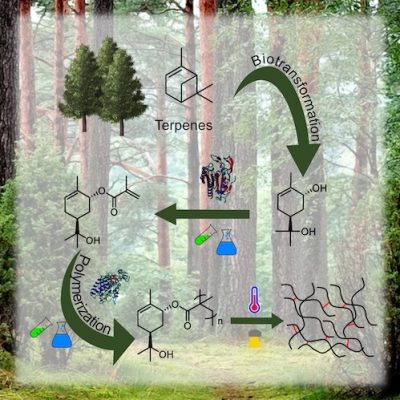Program 2: Biobased polymers and modelling (2019 – 2023)
Bio-based monomers and biopolymers – benign processing into materials and structure-property relationships

Research program
In essence, Program 2 is mainly dealing with all forest-based components, except for cellulose or nanocellulose, but the components may be used in combination with (nano)cellulose or wood.
It is impossible to envision today’s society without the use of plastic materials. However, conventional plastic materials are hampered by their non-degradability, with potential accumulation in nature as a consequence. The forest constitutes an almost inexhaustible source of eco-friendlier alternatives for tomorrow’s materials. Biopolymers may be used for material applications, or suitable small molecules isolated and subsequently polymerized into materials that can potentially replace fossil-based counterparts. Program 2 is focusing on biopolymers that can be isolated from forest products, except (nano)cellulose, and on bio-based polymers that can be obtained by polymerization of low molar mass extractibles or degradation products by sustainable methods, all in collaboration with Program 1. The rationale for the design of novel materials and the potential material applications will be assessed in collaboration with Programs 3 - 5.
Program 2 also aims at understanding why biopolymers are sensitive to water/humidity, which often circumvent their potential applicability in various material applications, and at elucidating the fate of biopolymer- and cellulose-based materials at the end-of-life.
Scientific impact
The scientific contributions of Program 2 aim to
- Develop efficient fractionation and isolation methods for biopolymers and smaller oligomers/monomers as well as eco-friendly/green methods to convert the small molecules into polymers. This will require the advancement of characterization techniques to investigate the impact of the biopolymers’ polydispersity as well as the development of efficient functionalization/polymerization pathways, requiring enzymes, high-yielding, selective chemistries, and/or robust, benign, polymerizations procedures.
- Isolate biopolymers exhibiting a specific functionality such as electrical conductivity, redox-properties, optical properties, specific adhesion characteristics, etc. Such plant biopolymers have interesting functions, such as controlled biodegradability, barrier function, etc., which can stimulate the synthesis of new bioinspired, bio-based, polymer systems.
- Understand why water constitutes a major limiting factor when it comes to exploiting cellulosic biomaterial in novel applications. The effects of water are ubiquitous but the molecular origins of those effects remain obscure. The molecular origins for water sensitivity will be investigated by combining NMR spectroscopy and molecular dynamics simulations.
- Develop methodologies and know-how required to assess the biodegradability of biopolymers (including nanocellulose and functionalized nanocellulose) and bio-based materials, especially in marine environments.
UN Sustainability Development Goals
Program manager
Eva Malmström
Professor, KTH





